Section 1 - Notice
This UIU for Small & Medium Business (UIU for SMB) installation should be initiated on an Administrator’s PC or server of choice (Admin Machine). The installation, with prerequisites, allows the UIU for SMB, (hereafter referred to as the UIU) to be integrated (to the extent possible) with the Microsoft Assessment and Deployment Kit (ADK) and will facilitate the production of deliverables to leverage the Deployment Image Servicing and Management (DISM) tools. The UIU will make no material changes to Windows ADK, Windows PE or ADK DISM tools. The Deployment solution will be capable of functioning in its original, prescribed manner without the employment of the UIU or after uninstallation of the UIU.

Section 2: General Information
The UIU is installed on a selected machine (Admin Machine), used by a network Administrator, and consists of a prepared driver database, administrative GUI (UIU Toolbox), and a set of wizards specific to Microsoft Deployment Image Servicing and Management (DISM). Upon installation of the UIU for SMB, the Toolbox can be used to manage the UIU Driver Repository and to launch wizards that allow the Administrator to prepare a a DISM deployment via boot media or create boot images for use in a Windows Deployment Services (WDS) environment.
Deliverables are designed to safely and seamlessly enhance OSD operations with fully automated driver management within Microsoft’s DISM utility, eliminating the need for Deployment Solution Administrators to locate, organize, manage, and package drivers.
Apply the UIU wizard’s output to the Windows Deployment Services and perform an OS deployment. The UIU then ascertains the onboard hardware of each recipient PC, and from its fully vetted and automatically updated driver database of over 40,000 Plug-and-Play IDs, stages the latest and most appropriate drivers for each hardware component prior to enumeration by Microsoft mini-setup.

Section 3- Change Control Information
- The UIU does not modify or otherwise interfere with WDS or any other PXE/Boot process. Troubleshooting PXE/Boot load issues is the customer’s responsibility.
- The UIU Updater application, will be installed in the system partition (typically C:\) under the Program Files subdirectory. This is common for any standard Microsoft application installation.

Section 4: System Requirements
- Admin Machine operating system must be Windows 7, 8 or Windows Server 2008, 2012 (or newer)
- .NET 4 runtime (This will be installed by setup if it is not detected) – Required for installation
- UIU for SMB License Key (This can be found on your license certificate) – Required for installation
- Administrator level access to the UIU Repository Directory, UNC path share with 20Gb free space minimum
- 1Gb free hard drive space on the Admin Machine
- Network connectivity for all target PCs to the UIU Repository – Required for deployment with UIU in Online mode
- Microsoft Windows Automated Deployment Kit (WADK): Requires at least Deployment Tools & Windows Preinstallation Environment (Windows PE) components

Section 5: Support Requirements
- Fully-functioning Deployment Solution, independent of the UIU
- Fully-functioning network infrastructure, including network share, (as UNC), and connectivity to that share from all target PCs

Section 6: Usage Restrictions
N/A

Section 7: Download and Installation Information
• The UIU for SMB by default will install on the system partition of the selected Admin Machine
• Permissions are controlled by AD/SCCM and must be set with visibility to the UIU Repository Directory
• The UIU for SMB may be downloaded from Big Bang LLC’s download sites

Section 8: Quick steps
- Open the UIU Toolbox application
- Manage the UIU and Deployment Settings, performing Online Updates, selecting the driver database and WinPE version to be used, and provideing network credentials for access to the installed (UNC) UIU Repository
- Select and complete the UIU wizard appropriate to the DISM operation (Capture or Deploy) of choice
- Create boot media or apply the wizard’s deliverable to WDS Deployment Solution if applicable
- Perform an OS deployment, using the Deployment Solution methodology augmented with UIU technology
Please refer to the UIU for SMB User Guide for complete instructions on how to deploy Windows operating systems with the UIU.

Section 9: Installing the UIU for SMB
Three files are required to install the UIU for SMB:
- Uiu5installer.exe
- Uiu5exe.dat
- Driver.dat
Execute “uiu5installer.exe” to begin the installation of the Universal Imaging Utility v5 (UIU for SMB).
Welcome Screen
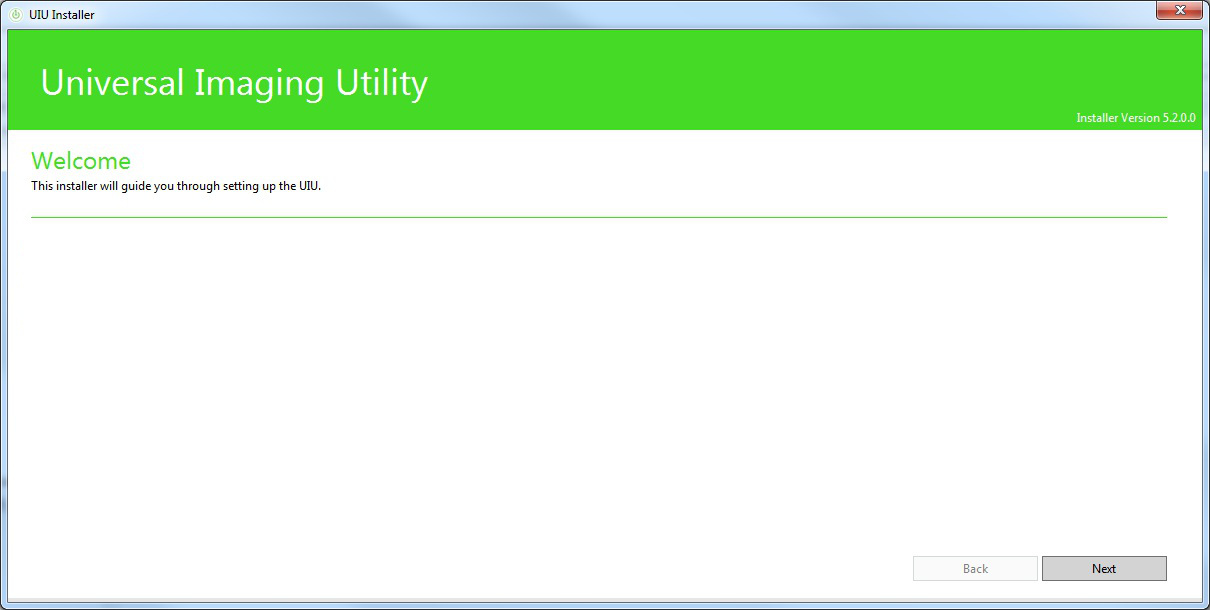 Click “Next” to proceed
Click “Next” to proceed
Licensing and EULA screen
Review the License Agreement, select "I Agree".
Enter UIU for SMB Live product License Key
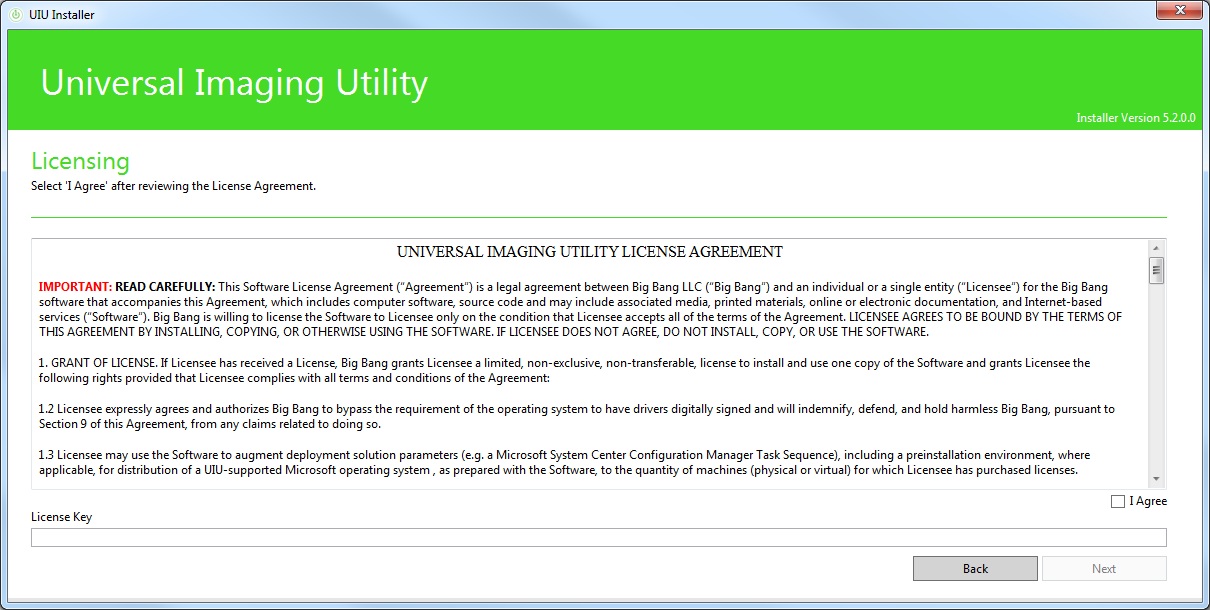 Click “Next” to proceed
Click “Next” to proceed
Prerequisites screen
Confirm that all prerequisites, necessary for the UIU for SMB to function, are installed
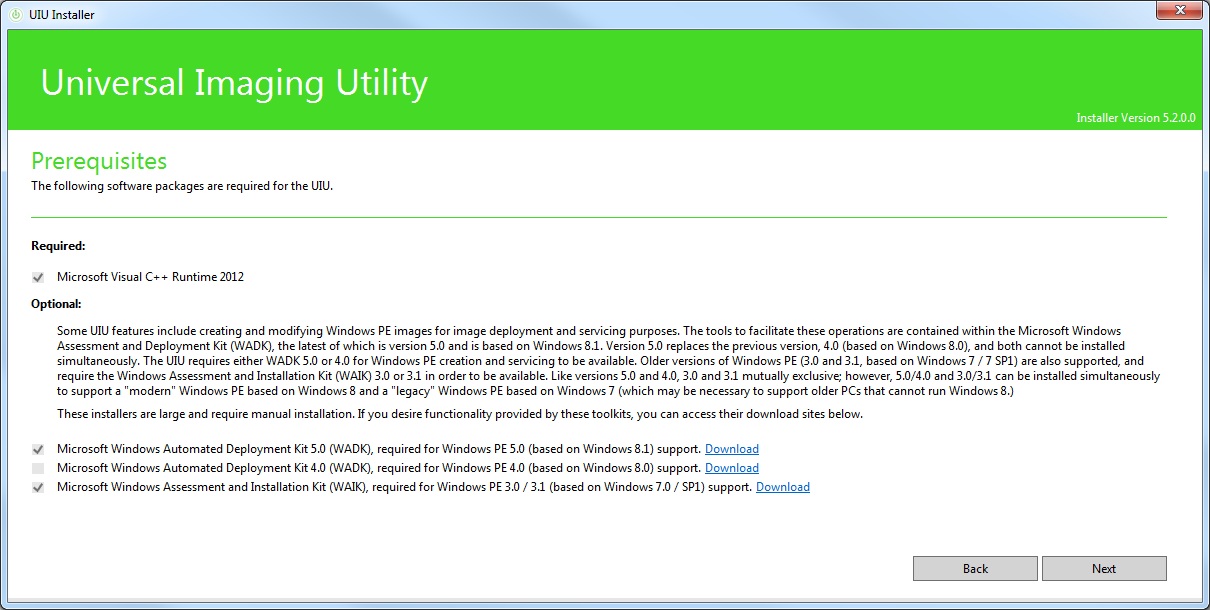 Select “Install” to initiate the installation of a missing prerequisite, displayed as an unchecked item in the list
Click “Next” to proceed
Select “Install” to initiate the installation of a missing prerequisite, displayed as an unchecked item in the list
Click “Next” to proceed
UIU Repository screen
Select the UNC Path to be used for the UIU Repository Directory (or if joining an existing UIU Repository where it has already been installed).
The UIU Repository houses the executables and driver files required for operation. The UNC path chosen should be accessible by all PCs that you intend to image in conjunction with the UIU. If accessing this location requires Credentials in order to access, please enter them on this screen.
Please be sure to create/select the existing Repository Directory prior to verifying the UNC path
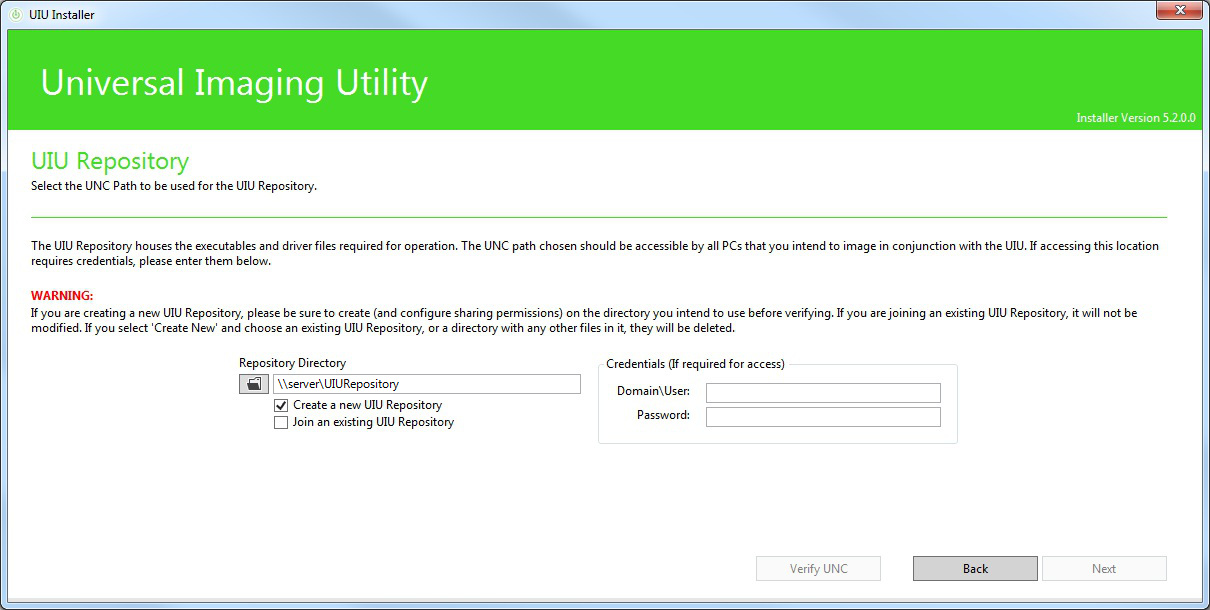 Click “Verify UNC” to test connectivity to the selected UIU Repository location, via UNC as a network share
Click “Next” to proceed
Click “Verify UNC” to test connectivity to the selected UIU Repository location, via UNC as a network share
Click “Next” to proceed
Installation screen
Confirm the Installation Directory and choose shortcut options
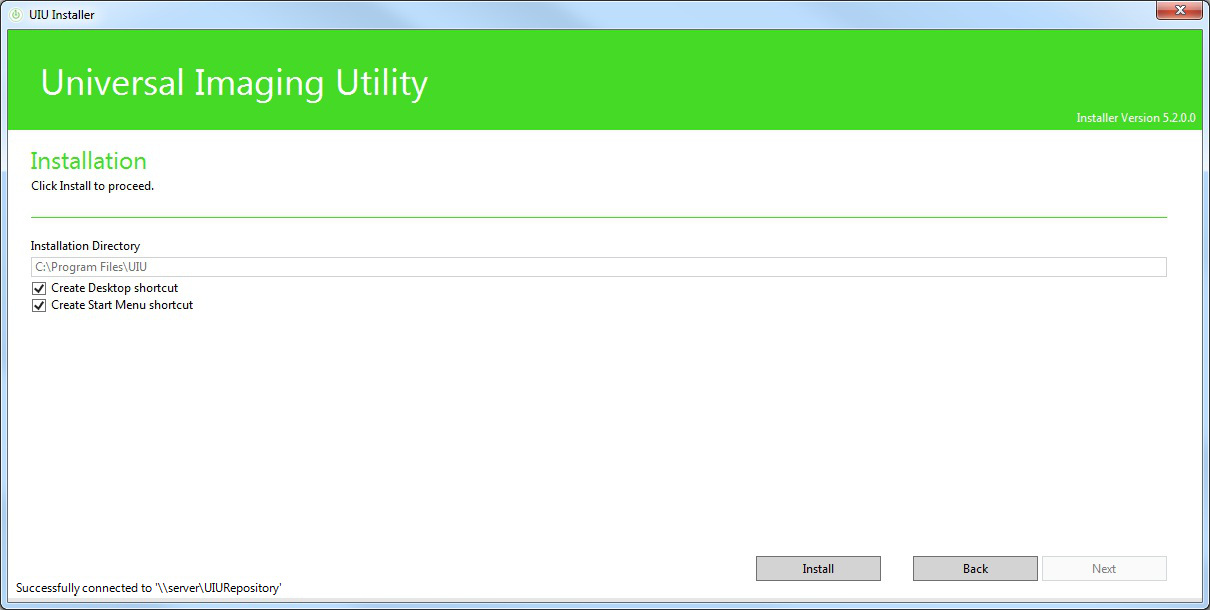 Click “Install” to initiate the installation of the UIU for SMB
Click “Install” to initiate the installation of the UIU for SMB

Section 10: UIU for SMB Trial Product Installation
The UIU for SMB Trial product installation is very similar to the Live product installation with the following notable exceptions:
When installing a trial version of the UIU for SMB, information will be presented regarding the limitations of the UIU for SMB Trial implementation, including timeout dates, etc.
Trial Limitations
 Click “Next” to proceed
Click “Next” to proceed

Section 11: UIU for SMB File Structure
The following files will be installed on the Admin Machine:
Default directory: C:\Program Files\UIU
\UIU5.exe
\uiu5installer.exe
\uiuupdater.exe
\UIU.log
\System\BBUtils.dll
\System\uiu5_v1.ico
\System\BigBang.dll
\System\SevenZip.dll
\System\x64\DismWrapper.dll
\System\x86\DismWrapper.dll
\SQLCE - (various files)
\Updater - (various files)

Section 12: Un-installing the UIU for SMB
The UIU for SMB may be uninstalled from Control Panel>Programs and Features>Universal Imaging Utility 5 and will completely remove all functional components of the software. The only exception may be folders that contain log files (e.g. C:\Program Files(x86)\UIU\UIULog.htm) which remain on the system. It should be noted that pre-requisite applications (e.g. Microsoft Windows ADK) installed via the UIU for SMB Installation will not be uninstalled with the UIU for SMB.
Alternatively, the UIU for SMB may be uninstalled by re-executing the UIU for SMB Installer application, “uiu5installer.exe”.
–––
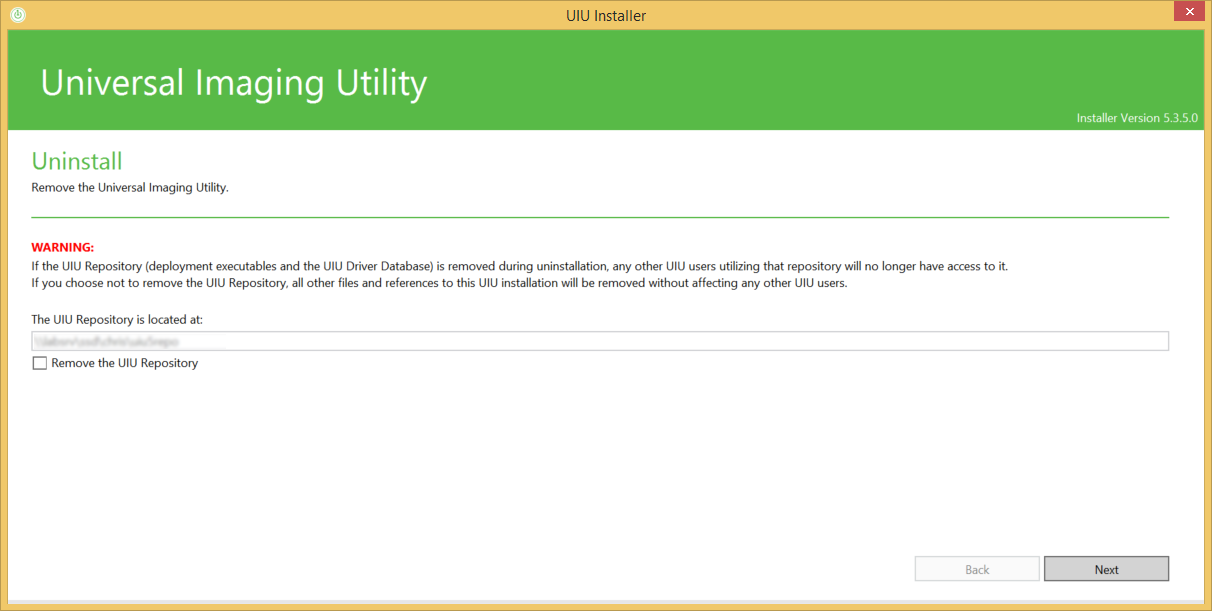 –––
–––
CAUTION! An option to also remove the installed UIU Repository is offered. Care should be taken before selecting the checkbox in the event that multiple UIU Toolbox applications are configured to use the same UIU Repository!

Section 13 - Disclaimer
No Warranty. This technical documentation is provided to you AS IS, and Big Bang LLC makes no warranty as to its accuracy or use. Any use of the technical documentation is at the risk of the user. Big Bang LLC reserves the right to make changes without prior notice.

Section 14 - Addendum - UIU for SMB with ImageX and DISM
ImageX, Microsoft’s native, command line based imaging tool, was released with Windows Vista as part of the Windows Automated Installation Kit (WIAK) and continued in use through Windows 7. Microsoft Deployment Image Servicing and Management (DISM), ImageX’s replacement, was released with Windows 8 as part of the Windows Assessment and Deployment Kit (WADK) and will be upgraded, not replaced, with the release of Windows 8.1. ImageX had been deprecated as of the
release of Windows 8.
- ImageX -> Windows Vista & Windows 7 (WAIK) + Windows PE v3.0 or v3.1
- DISM -> Windows 8 (WADK) + Windows PE v4.0 (v4.1 with Windows 8.1)
Customers familiar with ImageX can still use ImageX commands to create OS images (WIM files) for deployment. The UIU for SMB.x (specifically for DISM) will however, given the prerequisite of WADK upon install, utilize DISM commands behind the scenes to deploy the OS image regardless of whether DISM or ImageX was used to create the image.
Even if the customer determined that their older hardware required a version of Windows PE older than the one supplied in WADK and opted to also install WAIK for that purpose, and the older Windows PE (version 3.x) is used to boot the target PC, the UIU for SMB.x will use DISM commands to deploy the prepared WIM image.
What the customer needs to know about DISM:
First, a customer will need to have or build a DISKPART script. If the customer was using ImageX, they very likely had one prepared as partitioning is critical to image deployment. A script prepared for ImageX should not need to be modified to work with DISM. In the script, a drive letter is assigned on which to boot to Windows. This will be referenced in the Boot Configuration step of the DISM wizard.
This step allows the customer to select their prepared DISKPART script file for inclusion Sample DISKPART Script: (http://technet.microsoft.com/en-us/library/cc766465(v=ws.10).aspx)
- select disk 0
- clean
- create partition primary
- format quick fs=ntfs label=”Windows”
- assign letter=D
- active
A customer familiar with ImageX will be required to construct a DISM “apply-image” command (very similar to ImageX) detailing where the image to be deployed is stored, which image within the WIM file is to be used, and which drive letter (presented in Windows PE) to apply the selected image to.
A sample command line is presented in the wizard interface:
The Customer will also need to know, based on how the target drive has been formatted and partitioned, and where the windows boot directory is located, given the DISKPART script.
In this example, the deployed Target PC will attempt to boot Windows from D:\Windows
MSDN - BCDBoot Command-Line Options

Section 14 - Addendum - Windows ADK Requirement
UIU for SMB requires Windows Assessment and Deployment Toolkit (WADK v4.0) to be installed on the Admin machine. This requirement provides the capability of a modern (Windows 8) version of the Microsoft tools (incl. Windows PE) required to service a Windows PE image.
The specific components of WADK that are required include Windows Pre-Installation Environment and Deployment Tools. All other features are optional.
Windows Assessment and Deployment Kit (ADK) for Windows 8
Physical Address Extension (PAE), NX processor bit (NX), and Streaming SIMD Extensions 2 (SSE2) are features of the processor, and they’re needed to run Windows 8.0 or 8.1.
MSDN - What are PAE, NX, and SSE2?
- PAE gives 32-bit processors the ability to use more than 4 GB of physical memory on capable versions of Windows, and is a prerequisite for NX.
- NX helps your processor guard the PC from attacks by malicious software.
- SSE2 is a standard instruction set on processors that is increasingly used by third-party apps and drivers.
If your PC doesn’t support PAE, NX, and SSE2, you won’t be able to install Windows 8.0 or 8.1
If the processors of machines targeted for deployment do not meet the aforementioned processor requirements deployment tools will not be able to affect those target machines and therefore UIU for SMB users must also install Windows Automated Deployment Kit (WAIK v3.0) on the Admin Machine.
MSDN - The Windows® Automated Installation Kit (AIK) for Windows 7
In using the wizards included in the UIU for SMB Toolbox application, any “Windows PE” tab includes a selection entitled “Platform” wherein the version of Windows PE (derived from the installation of WADK and optionally WAIK) can be chosen based on the requirements of target machines. Choose the default of “Windows PE 4.0” if all of your target machines meet the requirements above. Choose “Windows PE 3.0/3.1” if some or all of your target machines do not meet the requirements above.
How To Check If Your Processor (CPU) Supports Windows 8